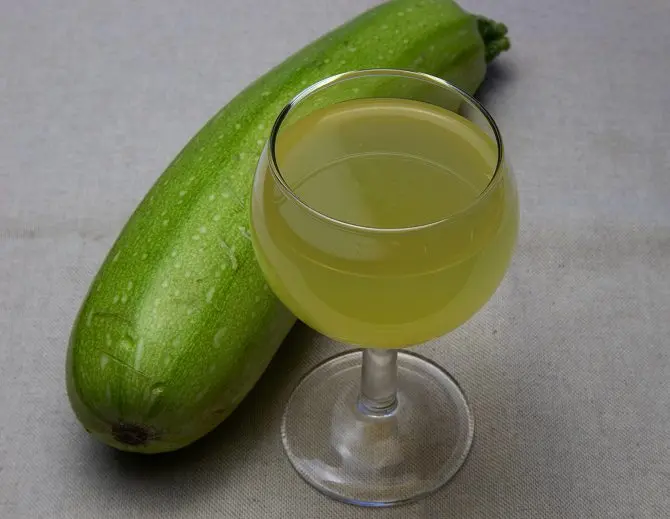A kind of vegetable wine for lovers of extraordinary drinks. It is remembered by a slight aftertaste of greenery and an almost complete absence of aroma. The hue depends on the variety of zucchini, mostly yellowish with green tints.
Before starting cooking, in order not to infect the wine with third-party microorganisms, it is necessary to steam sterilize all containers used.
Ingredients:
- zucchini – 2 kg;
- water (boiling water) – 4 liters;
- lemons – 3 pieces (or 15 grams of citric acid);
- sugar – 1 kg;
- unwashed raisins (fresh berries) – 50 grams (or wine yeast).
Lemons are needed to stabilize the acidity, there is little acid in the zucchini themselves and without additional acidification, fermentation will be weak.
Attention! The authors of some recipes suggest adding ordinary dry or baker’s yeast, but then instead of wine you get a mash with a specific smell and a sharp taste.
Zucchini wine recipe
1. If there is no wine yeast, then 3-5 days before processing the zucchini, you should prepare a wine sourdough from raisins or fresh berries (raspberries, currants, etc.), which will replace the yeast.
To do this, pour unwashed raisins (berries) into a jar, add 25 grams of sugar, pour 150 ml of water at room temperature. Mix, bandage with gauze and put in a dark warm place. When foam appears, hissing with a slight sour smell (usually after 2-3 days), the starter is ready and you can proceed to the next step.
If mold has appeared, it means that the sourdough is infected and you will have to start all over again, using other raw materials for cooking.
2. Wash the zucchini, cut into several pieces, remove the core and seeds.
3. Pass the pulp together with the peel through a meat grinder or grind it in any other way, for example, with a blender, until a homogeneous mass is obtained.
4. Put the resulting slurry into an enameled pan with a wide neck, pour boiling water over it, mix, cover with a lid. Leave for 24 hours.
5. Filter the contents of the pan through several layers of gauze, squeeze the pulp well.
6. Add 0,5 kg of sugar, citric acid and the sourdough made at the first stage (without berries) or wine yeast to the resulting squash juice. Mix.
7. Pour the wort into a fermentation tank, fill to a maximum of 75% to leave room for the next portions of sugar, foam and carbon dioxide. Install a water seal of any design on the neck, for example, a medical glove with a hole in one of the fingers.

8. Transfer the container with the future marrow wine to a dark place (can be covered) with a temperature of 18-27°C.
9. After 5 days, remove the water seal, drain 0,5 liters of fermenting must separately, stir 250 grams of sugar in it. The resulting syrup is poured back into the fermentation tank and closed with a water seal. After another 5 days, repeat the described procedure, adding the last portion of sugar – 250 grams.
10. Depending on the temperature and yeast activity, the fermentation of zucchini wine lasts 25-60 days. The end of the process is indicated by the absence of gas from the water seal (the glove was blown off) and a layer of sediment at the bottom. Fermented wine must be drained through a straw into another container without sediment.
11. Try a drink. If desired, sweeten with sugar to taste or fix with vodka (alcohol) 2-15% of the volume. In this case, fixing almost does not affect the taste and aroma, it only increases the strength.
12. Fill storage containers with wine (preferably to the top to avoid contact with oxygen) and seal tightly. If sugar was added, keep the first 7-10 days under a water seal in case of repeated fermentation.
13. Transfer the wine for aging to a dark, cool place with a temperature of 5-16°C (refrigerator, cellar or cellar). Leave for 3-4 months.
14. Once every 20-30 days, as a precipitate appears with a layer of 3-5 mm, filter the drink by pouring it through a straw.
15. When the sediment no longer appears, the zucchini wine is ready. It can be bottled and corked. Fortress – 10-12%, shelf life when stored in the basement – 2 years.










